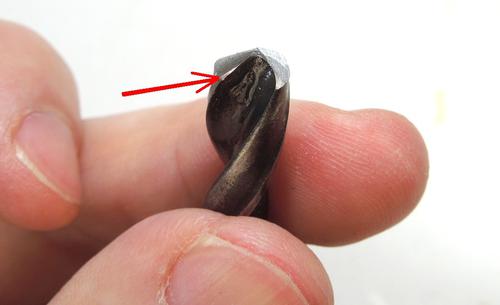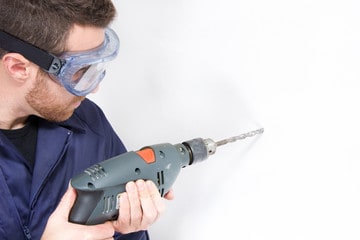Drill bits can be broken due to these 9 reasons such as selecting the wrong drill bit, manufacturing faults, clogging the swarfs, not using cutting oils, applying too much thrust, drilling in high RPM, and using improper drills and drilling bits. These reasons are mainly affecting any drill bit breaking.
The most broken drill bits are wood drill bits and metal drill bits. Because those drill bits should be used in specific conditions. If those exceed, drill bits can be broken easily. You can prevent the drill bit from breaking by using a proper strength drill bit, using a proper flute density drill bit, using lubrication and cutting oils, applying enough pressure, using proper RPM, and using a proper drilling machine.
What are the 9 Reasons for Drill Bit Breaking?
1. Manufacturing Faults on Drill Bit
Drill bits are made with many combined materials. When they are manufactured and sharpened, some cracks and faults can occur easily. When the fault drill bit is used, it can break easily.
In the modern market, there are cheap and low-quality products. Those are made with low-quality materials and technologies. If you use it in order to cut the budget, you may face many problems. So when you select a drill bit, make sure it is from a well-known brand.
2. Choosing a Wrong Drill Bit

Using a wrong drill bit can cause many problems. The drill bit should be selected according to the drilling material and drill machine. Wrong drill bits always overheat quickly, produce more chips, require less heat conduction, need more lubricants, produce smoking during drilling, and less efficiency during the drilling. So you should use the below-recommended drill bits for each material.
- Low Carbon Steel – Suitable for wood
- High Carbon Steel – Used both wood and metal.
- High-Speed Steel Drill Bits – These bits can be used to drill metal or hardwood. Materials that are not able to be cut using the high-carbon steel HSS is used.
- High-speed Steel with Cobolt – Drill stainless steel and more drilling strength than HSS
- Carbide Drill Bits – Used for stone, Bricks, concrete, metals, woods
- Polycrystalline Diamond Drill bits – These are used to drill tiles, stones, and glasses.
3. Swarf Clogging Inside the Flutes
Drill its can be broken due to swarf clogging inside the drill bit flute. These swarfs removal rate depends on the cutting speed. Due to high-speed drilling, those are generated highly. If any problem occurs to clog inside, inner friction can be increased, and tool temperature is increased. Hence drill bit can get hot. And finally, drill bit can be broken. You can cool the drill bit using these methods.
When you drill, make sure to keep the space to remove the swarf. Normally keep free two times the diameter from the top of the drill bit. That means do not drill until flutes are not showing to you. There should be a safe space to remove the swarf from the drilling hole. If you drill wet wood, you can see, the swarf is always clogged due to wet conditions. You can remove them while you are drilling.
When you drill, do not apply the same force constantly. Thrust and release it and pull a bit out. In this process, swarfs can be removed easily.
4. Lack of Cutting Oil for Drilling
When you drill metal, you should use cutting oil. Cutting oil can lubricate the drill bit. Hence it can reduce the friction between the drill bit and hole surface. As well as cutting oil can transfer the generated heat away from the drill bit. Both of these can cool the drill bit and increase the service life easily.
Without cutting oils, tools and materials can be heated due to friction. Hence drill bits can be broken easily. When you use cutting oil, you can see chips are removed smoothly, and there are no internal cloggings. Due to this reason, you can drill fast.
5. Apply too Much Thrust on Drill Bit
Applying too much thrust on the drill bit will increase the feed rate. It will cause to produce more force from the drilling machine and produce more friction. When the friction is increased it can generate more heat and the result will break the drill bit.
Hence you should apply force to the drill as the drill bit smoothly feed into the material. A proper thrust will generate 1″-2″ continuous swarfs from the drilling bit.
6. Drill With a Higher RPM
When you drill at high speed in the metal and wood, the drill bit can be heated much due to friction. This will be a reason for breaking the drill bit easily. Normally, wood requires a higher RPM for drilling, and metal and concrete require a lower RPM for the drilling process.
Most of the drill bits are broken due to this reason. You must use the recommended drilling speed for each material. This can be varied with the products. Some products can use at high speed. But most are not. You can use this table for wood, brass, aluminum, and steel drilling RPMs for twist drill bits.
| Twist Drill Bits | Soft Wood | Hard Wood | Acrylic | Brass | Aluminium | Steel |
| 1/16″ to 3/16″ | 3000 RPM | 3000 RPM | 2500 RPM | 3000 RPM | 3000 RPM | 3000 RPM |
| 1/4″ to 3/8″ | 3000 RPM | 1500 RPM | 2000 RPM 1 | 1200 RPM | 2500 RPM | 1000 RPM |
| 7/16″ to 5/8″ | 1500 RPM | 750 RPM | 1500 RPM | 750 RPM | 1500 RPM | 600 RPM |
| 11/16″ to 1″ | 750 RPM | 500 RPM | NR | 400 RPM | 1000 RPM | 350 RPM |
7. Drill in High Temperature
Temperature is really negative effect on the drilling process. While you drill a high-temperature area, you can observe the produced temperature is not transferred properly. Due to this, the drill bit and drill also overheated, which can be broken easily. In this situation, cutting oil will not transfer the heating out, so heating up and damage can occur.
Normally, coated drill bits are highly resistant to heating and abrasion. Hence you can use coated drill bits when you drill such kinds of materials.
8. Use Improper Drill Bits
If your drill bit is not sharpened and there is no proper cutting angle, you cannot drill in a proper manner. If there is no proper cutting angle drill bit will be slippering and produce more heat. This heat can break the drill bit. Sometimes wood drill bits are damaged due to inside nails, and its cutting path is damaged seriously. You can observe its swarf are not out properly.
Properly sharpened drill bits produce 1″-2″ swarfs outside the drilling hole. So, immediately sharpen the drill bit with proper angles.
You must maintain the below angle in the drilling process.
- 118 Degree- Soft material like wood and aluminum
- 135 Degree – Hard material like stainless steel
9. Combinations of Different Materials
Some nails deeply penetrate the wood. And some can be a break as one part inside. When you drill such a place, your drill bit can easily break due to the inside nail part. So you had better pay your full attention to the drilling material. If that is old wood, check carefully to avoid this kind of problem.
When you drill into concrete, you can observe this. Concrete includes steel to increase tensile strength. So when you drill, there is steel inside.
If your drill bit is not designed for Both materials, do not continue the work. Use any bar cutter and then drill it again. If you use SDS max drill with the proper drill bit, you can drill both together.
How to Avoid Drill Bit Breaking?
You can avoid drill bit breaking by following the below 6 methods.
- Use correct drilling speed – The speed of the drill should be set correctly according to the type of material being drilled. Drilling at a too-high speed can generate excessive heat, causing the drill bit to break.
- Apply proper lubrication during drilling – Lubrication is crucial when drilling into hard materials like metal. It reduces friction and heat, thus preventing the drill bit from overheating and breaking.
- Choose the right drill bit – Use the correct drill bit for the material you’re working with. For example, use a masonry bit for concrete, a twist bit for wood, and a step bit for sheet metal. Using the wrong bit can cause it to break.
- Apply steady pressure on the drill bit – Apply steady, even pressure when drilling. Excessive force can cause the bit to break.
- Start drilling with predrilled holes – For thick or hard materials, it may be beneficial to pre-drill a smaller hole before drilling the final hole. This reduces the pressure on the drill bit.
- Regularly check the drill bit – Regularly check the drill bit for signs of wear or damage. If a bit is worn out or damaged, it’s more likely to break. Replace worn-out bits promptly.
.

